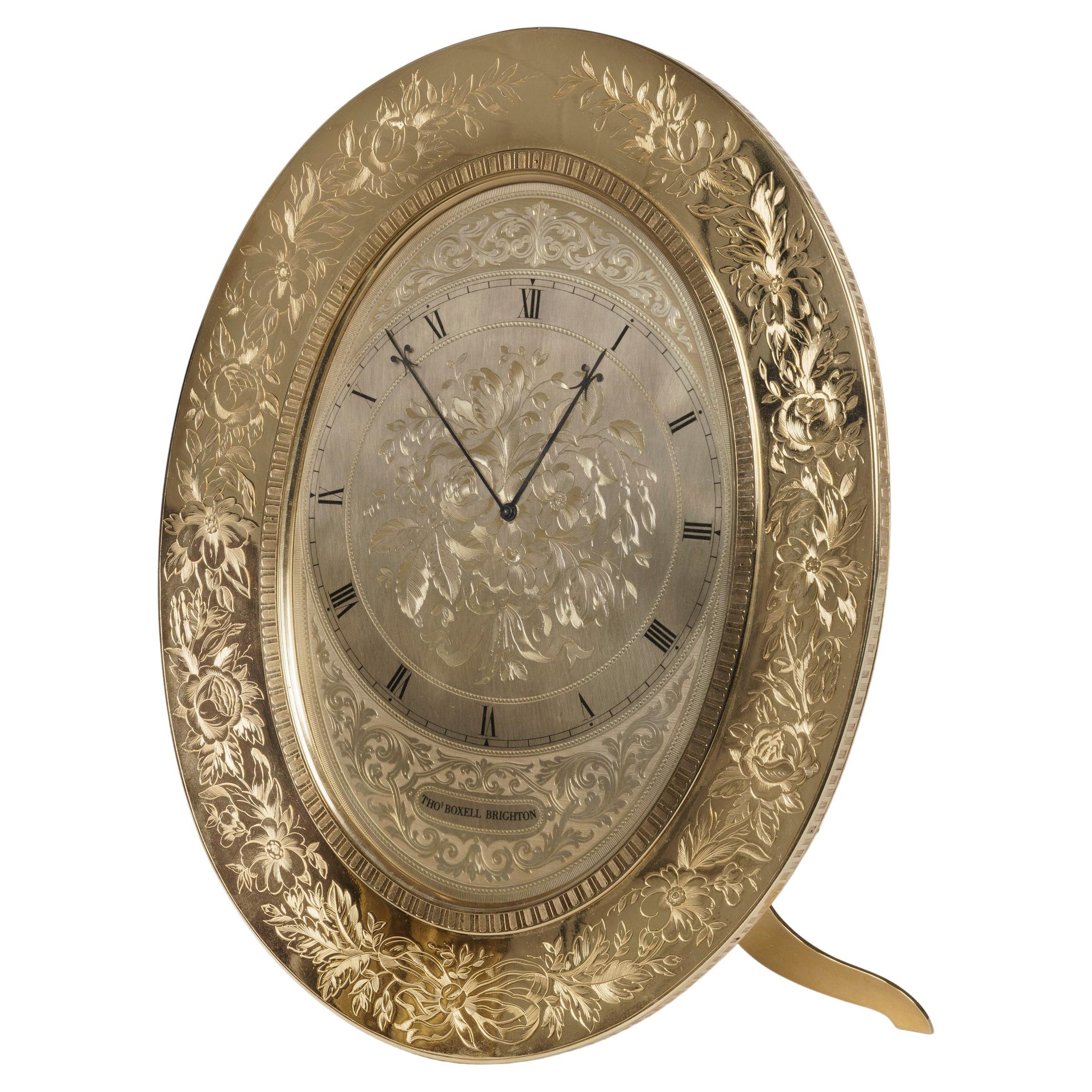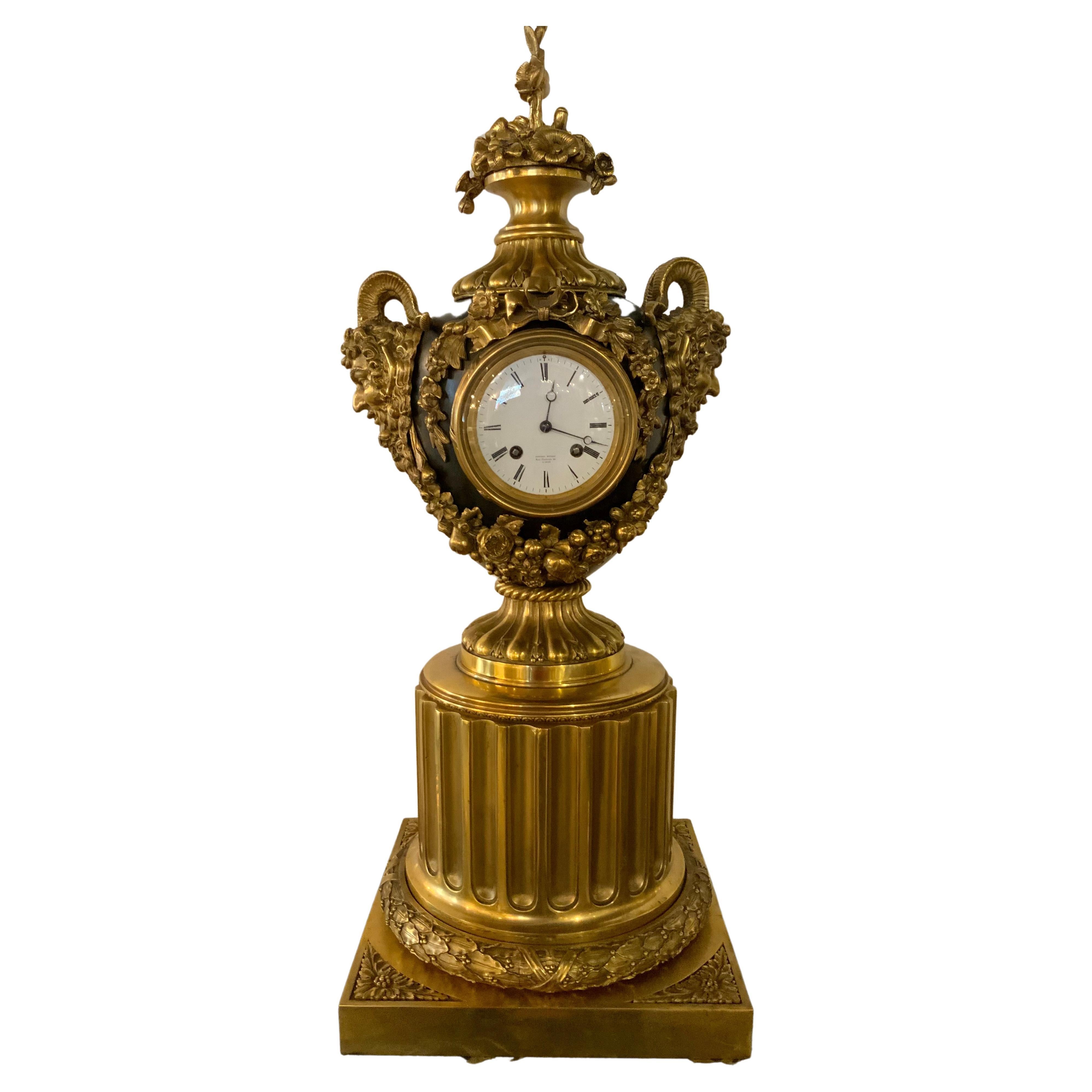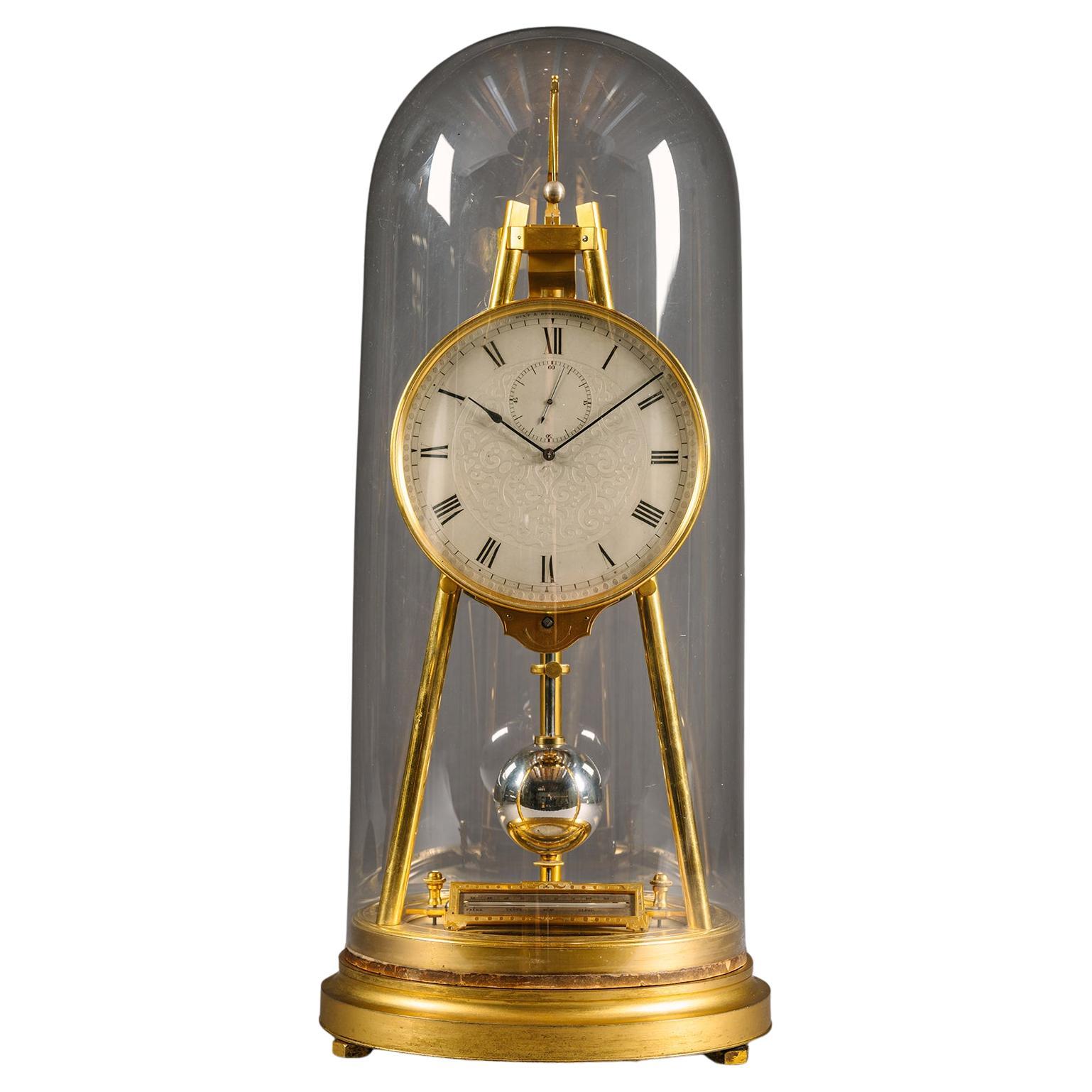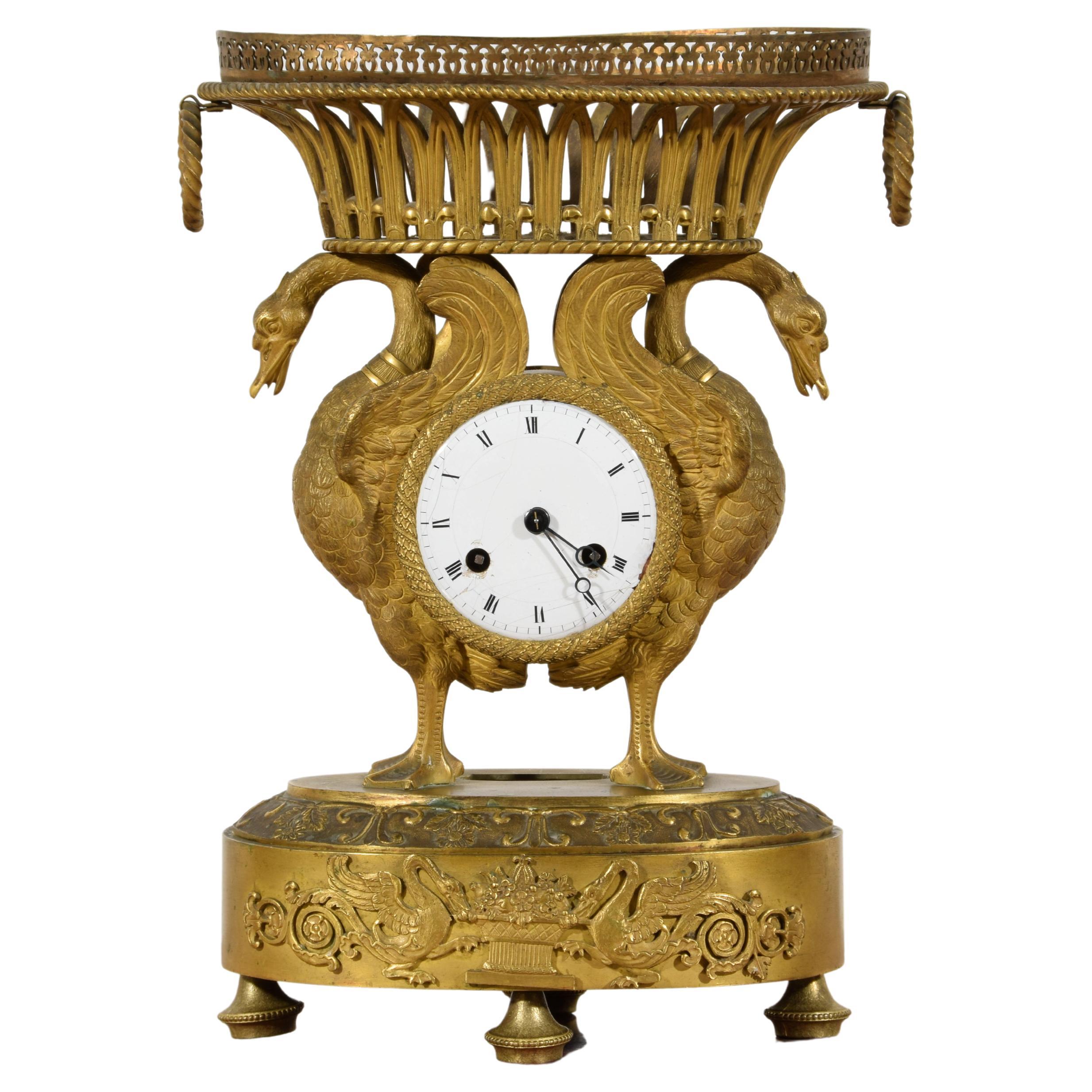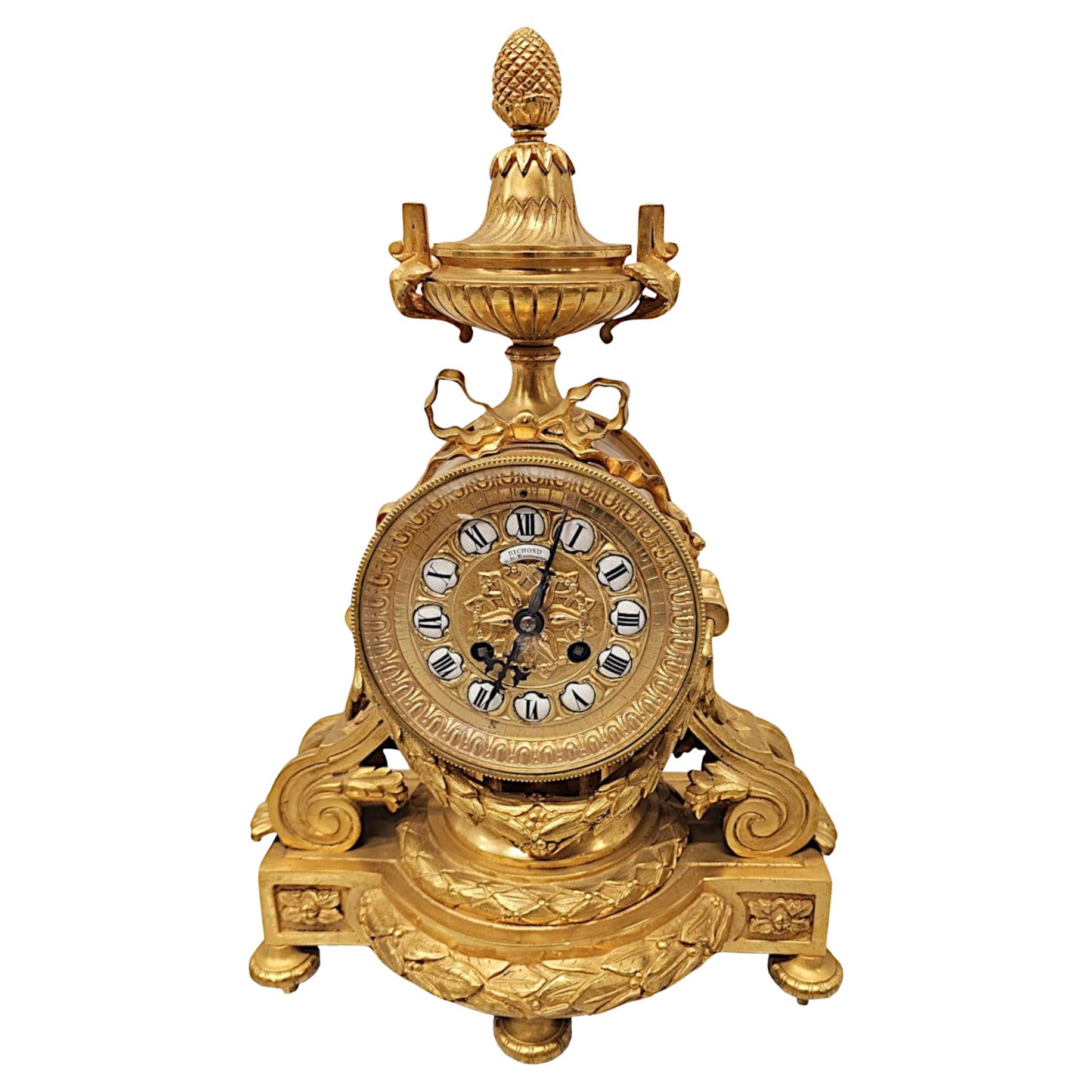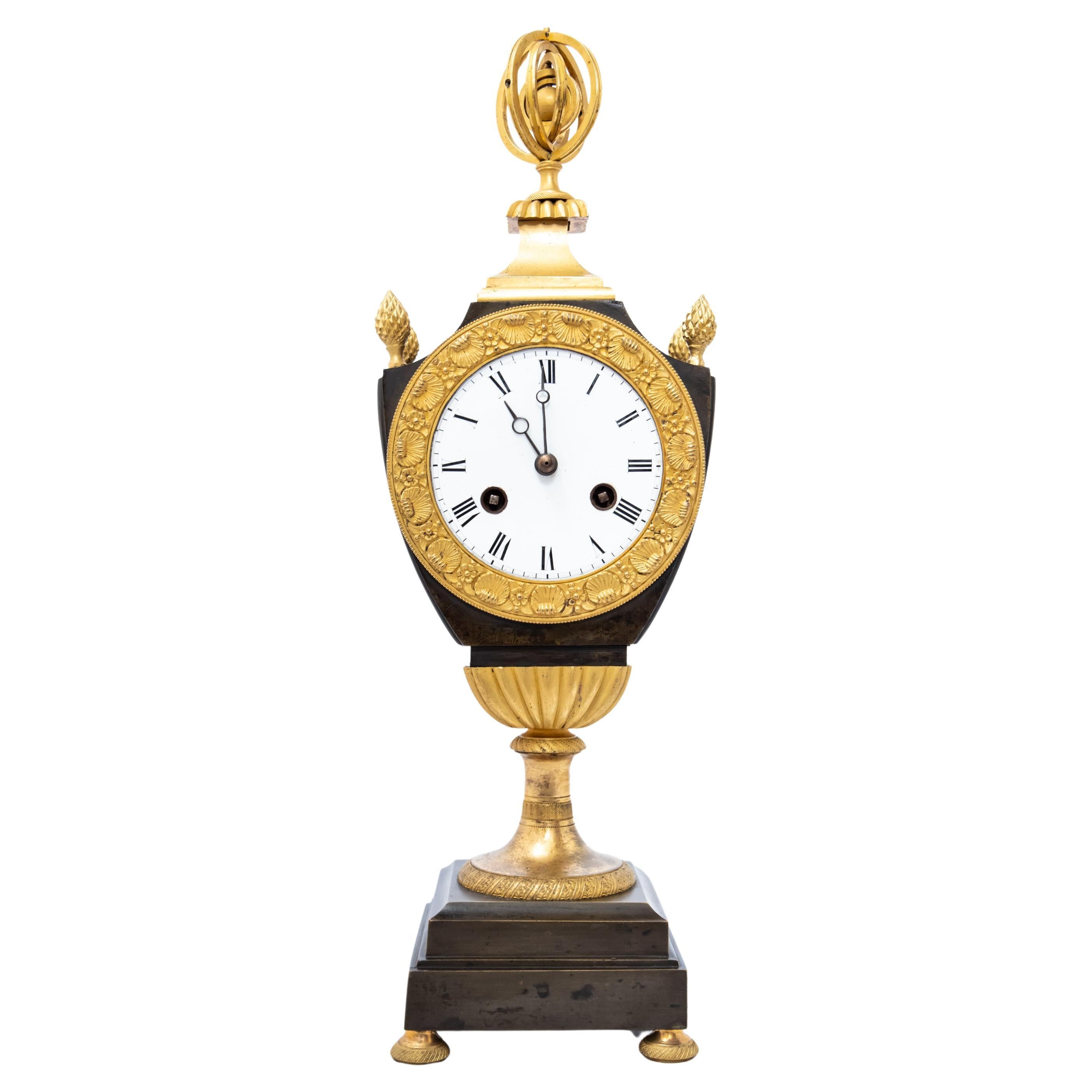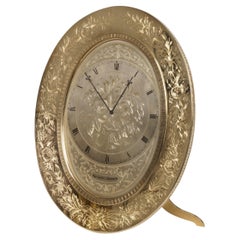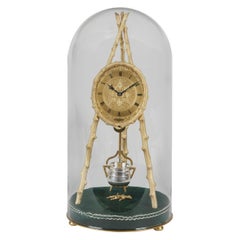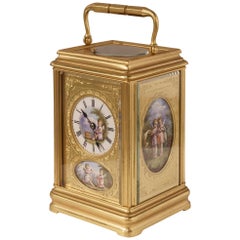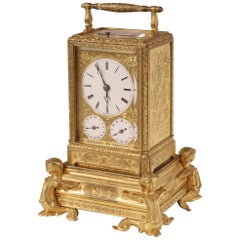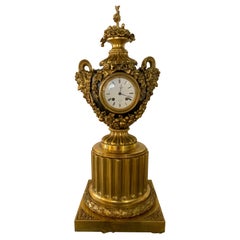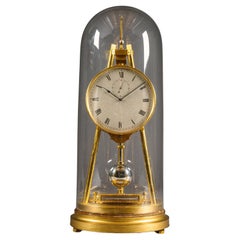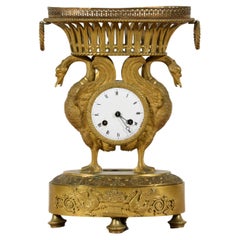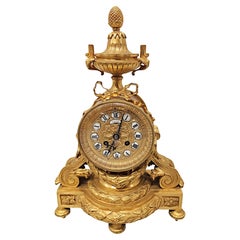Items Similar to Rare 19th Century Brass Engraved 'Inkwell' Table Clock attributed to Thomas Cole
Want more images or videos?
Request additional images or videos from the seller
1 of 6
Rare 19th Century Brass Engraved 'Inkwell' Table Clock attributed to Thomas Cole
$34,090.23
£25,000
€29,029.74
CA$46,974.69
A$51,636.63
CHF 27,108.99
MX$613,996.70
NOK 348,141.01
SEK 317,118.83
DKK 216,898.72
About the Item
An Unusual 'Inkwell' Table Clock
Attributed to Thomas Cole
Constructed from gilt brass, the novelty timepiece rising from a turned ebonised base inset with a concave brass tray engraved with geometric strapwork; a central socle supporting the inkwell, its exterior finely engraved in conforming manner, opening up to reveal a cut glass inkwell, its lid inset with an engraved silvered dial, with fleur de lys blued steel hands denoting the hours in Roman numerals and the minutes by way of a chapter ring; the movement with going barrel, lever escapement, and steel balance. Bearing a presentation inscription to James MacHenry dated 1883.
Circa 1860
Dimensions: H: 10 in / 25.5 cm
The inventive design for this clock sits alongside a small number of other unusual clocks created by Thomas Cole. According to J.B. Hawkins, there was "no doubts that these clocks took many years to complete under constant supervision to ensure the incredibly high standard attained."
- Attributed to:Thomas Cole (Clockmaker) (Clockmaker)
- Dimensions:Height: 10 in (25.4 cm)Diameter: 10 in (25.4 cm)
- Materials and Techniques:
- Place of Origin:
- Period:
- Date of Manufacture:circa 1860
- Condition:Repaired: Our clock conservation and restoration expert has serviced the movement and its case guaranteeing the clock is in working condition. Wear consistent with age and use.
- Seller Location:London, GB
- Reference Number:Seller: 96581stDibs: LU954726461062
About the Seller
5.0
Recognized Seller
These prestigious sellers are industry leaders and represent the highest echelon for item quality and design.
Established in 1964
1stDibs seller since 2012
54 sales on 1stDibs
Typical response time: <1 hour
Associations
The British Antique Dealers' AssociationLAPADA - The Association of Arts & Antiques Dealers
- ShippingRetrieving quote...Shipping from: London, United Kingdom
- Return Policy
More From This Seller
View AllLarge Gilt Brass Engraved Oval Table Clock by Thomas Cole
By Thomas Cole (Clockmaker)
Located in London, GB
A large oval strut clock
By Thomas Cole
The case constructed from gilt brass and designed to be as thin as possible, finely engraved throughout, of substantial oval size, and supported by means of a fold-out foot, the outer frame with floral engraved border, the silvered dial decorated in conforming manner and denoting the hours in Roman numerals with blued steel hands, its centre decorated in foliate patterns; the movement with four turned pillars, spring barrel, steel balance and lever escapement and signed to the backplate by the retailer, also denoted on the dial's cartouche "Thos Boxell, Brighton," and numbered to the rear.
Circa 1860
Dimensions: H: 11 in / 28 cm
Comparative Literature:
Hawkins, J. B. Thomas Cole & Victorian Clockmaking. Woodbridge: Antique Collectors' Club, 1975; p. 90 (item 28), illustrating a related large oval strut clock.
Thomas Cole (1800-1864)
Son of Thomas Cole Snr, a Somerset clockmaker, Cole is known as a specialist in making decorative timepieces of the highest quality. He exhibited at the Great Exhibition at the Crystal Palace in 1851; he warranted an 'honourable mention' in the Paris Exposition universelle of 1855 and the London 1862 International Exhibition, where he was awarded a medal for 'excellence of taste and design'.
Thomas Boxell of Brighton...
Category
Antique 19th Century English Table Clocks and Desk Clocks
Materials
Brass
Early Tripod Table Clock by Thomas Cole with Glass Dome
Located in London, GB
An extraordinary rustic tripod table clock
by Thomas Cole
Retailed by E. White of London
The circular green velvet-clad base supporting three equidistantly spaced brass imitation logs, from which the clock and its mechanism are suspended; housed within a brass bezel conformingly styled as naturalistic logs, the circular etched and engraved gilt dial with elegant blued steel hands, marked at 6 o'clock "E. White, 20 Cockspur St, London", having the hours marked in Roman numerals; the tapered two-tier movement has a six wheel train with five-spoke crossings between spotted plates, the upper section fixed by blued steel screws to the backplate, enclosing a Brocot-style deadbeat escapement incorporating rubies and train to the centre wheel, the pendulum of most unusual design styled as a lidded cauldron over a simulated fire. Complete with a glass dome and key. The front plate numbered “1637.”
London made, circa 1861
Thomas Cole, (1800-1864)
Son of Thomas Cole Snr, a Somerset clockmaker, his history and works are fully recorded in 'Thomas Cole & Victorian Clockmaking' by John B. Hawkins, published 1975, in Sydney. Known as a specialist in making decorative timepieces of the highest quality, Cole exhibited at the Great Exhibition at the Crystal Palace in 1851; he warranted an 'honourable mention' in the Paris Exhibition of 1855 and the London 1862 Exposition International, where he was awarded a medal for 'excellence of taste and design'.
Hawkins discuss Thomas Cole's tripod clocks...
Category
Antique 19th Century English Table Clocks and Desk Clocks
Materials
Brass, Ormolu, Bronze
19th Century Hand Painted, Engraved and Gilt Brass Carriage Clock
Located in London, GB
A fine carriage clock
The engraved gilt case rises from an ogee plinth, and is dressed with elliptical polychrome enameled plaques to the fascia and the sides, depicting children ...
Category
Antique Late 19th Century French Carriage Clocks and Travel Clocks
Materials
Brass
19th Century French Petite Sonnerie Ormolu Carriage Clock by Grohé with Calendar
Located in London, GB
A Petit Sonnerie carriage clock by Grohe of Paris
The gilt bronze case comprehensively engraved, and having a retractable carrying handle; the lever movement driving the petit son...
Category
Antique 19th Century French Carriage Clocks and Travel Clocks
Materials
Ormolu, Brass, Bronze
Very Rare 19th Century Coromandel Veneered Year-Running Clock by Thomas Cole
By Thomas Cole (Clockmaker), Achille Brocot
Located in London, GB
A Superb Coromandel-Veneered Mantle Clock
The case constructed of very well-figured Coromandel giving the maximum amount of decorative effect, with gilt bronze accents; the plinth base of rectangular form, with everted stepped corners, and precisely chased gilt bronze figures, two representing Mercury-the god of travel and merchants with his winged helmet and coin purse in hand; the others representing Fortuna-the goddess of luck; the sides glazed, with mooresque arcaded pierced mounts enclosing a vase, in gilt bronze with overlapping palm trees above: the top of domed form with an octagonal platform, surmounted by an architectural dome, its engraved detail and structure reminiscent of Byzantine prototypes. The silvered chapter ring with Roman numerals for the hours, and within an arabesque dial divided into quadrants, with the key aperture at 6 o'clock. Below, the manual calendar, and a semi-circular thermometer. The dial signed by the retailer "Hunt & Roskell / London." The mechanism replaced with a one-year duration movement by Achille Brocot.
English, circa 1860
A closely related clock, by Thomas Cole, though not bearing his signature, with a case of identical form and differing bronze decoration, previously with Butchoff. A third known coromandel-veneered example, also unsigned, is discussed by John...
Category
Antique 19th Century English Table Clocks and Desk Clocks
Materials
Brass, Ormolu
19th Century French Charles X Period Foliate Inlaid Mantle Clock with Calendar
Located in London, GB
A French mantel clock of the Charles X period.
Constructed in palisander, foliate and line inlaid in boxwood; rectangular form case, surmounted by a gilt bronze carrying handle, h...
Category
Antique 19th Century French Charles X Clocks
Materials
Boxwood
You May Also Like
Gilt Bronze and Ebony Table Top /Mantel Clock French 19 Th Century
Located in Houston, TX
This clock is very dramatic in appearance with bright gold gilt ornamentation
With designs in floral and foliate elements. Gilt masques decorate the
The sides. The clock is in goo...
Category
Antique 19th Century French Table Clocks and Desk Clocks
Materials
Bronze
$8,750 Sale Price
30% Off
English Tripod Table Regulator Clock by Thomas Cole, Retailed by Hunt & Roskell
By Thomas Cole (Clockmaker)
Located in Brighton, West Sussex
A Fine English Tripod Table Regulator Clock by Thomas Cole, With Integral Thermometer and Barometer, Retailed by Hunt & Roskell, London
Signed to the dial for the retailer ‘Hunt & Roskell, London.’
No. 1318 /38
The circular six-inch silvered dial with cast bezel, signed ‘Hunt & Roskell, London’, above Roman chapters and blued steel spade hands, set with a large subsidiary seconds dial below XII, the centre finely engraved with scrolling strapwork decoration. The steel winding square protruding through an engraved and shaped plate immediately below 6 o'clock with handset achieved by adjustment to the rear. The movement with tapered plates joined by cylindrical screwed pillars, a two-part backplate, a going barrel, and deadbeat escapement. The pendulum suspended from the apex of the tripod from a G-bracket, with plumb line above, fine regulation achieved by a sliding cylindrical weight on the rod, terminating in a heavy silvered spherical bob secured via Cole's pendulum-locking system.
The case formed of three cylindrical rods set on a gilt and stepped circular base engraved with scrolling foliage, the recessed centre with a semi-circular glazed barometer with silvered register scale, blued steel hand and manually adjustable gilt recording hand. The tilted thermometer within an engraved and gilded surround. Below the tip of the pendulum is a beat scale resting on a bimetallic bar providing thermal compensation, the base resting on three adjustable gilt-metal levelling nuts.
Retaining its original glass dome and brass winding key.
England, Circa 1855.
This fine and rare timepiece by Thomas Cole is a masterpiece of design.
Described by Hawkins in 'Thomas Cole & Victorian Clockmaking' as “the first English table regulator for a gentleman’s library table,” Cole’s strut clock underwent over eight iterations before achieving a design that combined precision with extraordinary elegance.
The use of a tripod to determine the optimal pendulum suspension point is just one of several ingenious mechanisms Cole employed. Three adjustable nuts serving as feet allow for effective levelling of the clock, while a plumb line and bob ensure precise vertical alignment. Relocating the winding square directly beneath the dial eliminates the risk of scratching the surface or damaging the hands, while the inclusion of a thermometer, angled at 45 degrees, effectively conceals the beat scale and pendulum locking mechanism.
Ingeniously designed, the locking mechanism positioned just below the pendulum’s tip includes a beat scale resting on a brass bar that can be raised to secure the pendulum in place. This mechanism also provides thermal compensation through a bi-metallic strip, which automatically raises or lowers the bob in response to temperature fluctuations.
Both inventive and aesthetically striking, this rare clock exemplifies the highly ornamental Victorian timepieces...
Category
Antique 19th Century English Victorian Table Clocks and Desk Clocks
Materials
Brass, Bronze, Steel
19th Century, French Chiselled and Gilt Bronze Table Clock
Located in IT
19th century, French chiselled and gilt bronze table clock
This table clock was made of chiselled and gilded bronze in the early 19th centur...
Category
Antique Early 19th Century French Empire Table Clocks and Desk Clocks
Materials
Bronze
19th Century Gilt Bronze Mantle Clock By Richond of Paris
Located in Dublin, IE
A stunning 19th Century gilt bronze mantle clock by Richond of Paris, stamped by the maker H & F and is of exceptional quality. The finely cast gilt bronze clock in the Neoclassical...
Category
Antique 19th Century French Mantel Clocks
Materials
Bronze, Enamel
Patinated and Fire-Gilt Clock in the Form of a Vase c. 1800
Located in 263-0031, JP
A French patinated and fire-gilt clock in the form of a vase, Empire Era, 1800-1815. The silk-thread mechanism is in good working condition with key and pendulum.
Category
Antique Early 19th Century French Empire Table Clocks and Desk Clocks
Materials
Bronze
$2,064 Sale Price
20% Off
Table Clock in Gilded Bronze, France, First Half of the 19th Century
Located in Milano, IT
Gilded and chiseled bronze clock. On the large rectangular base there is a scene with mythological divinities in relief on a finely chiseled background. Decorations with plant motifs...
Category
Antique Early 19th Century French Other Table Clocks and Desk Clocks
Materials
Bronze
More Ways To Browse
Used Thomas Table
Small Clock
Engraved Brass Table
Brass 19th Century Inkwells
Glass Inkwell With Brass Lid
Engraved Wood Table
Antique Wood Inkwell
Engraved Brass Tray
Inkwell Glass With Lid
Cole Clocks
J Cole
Mechanical Desk
United Clocks Deco
Italian Brass Clock
Clocking Machine
Italian Bronze Clock
Art Deco Enamel Clocks
Homer Watch
